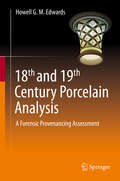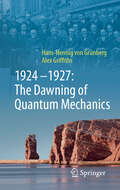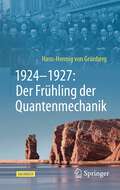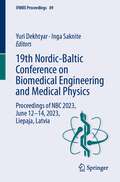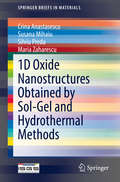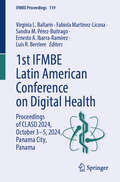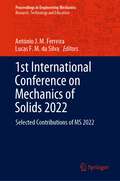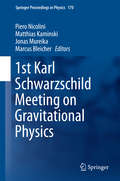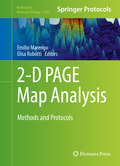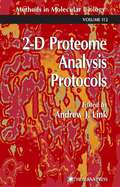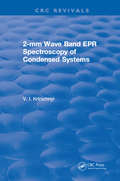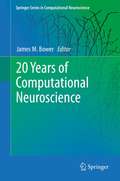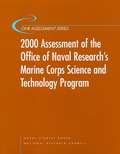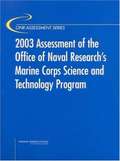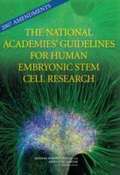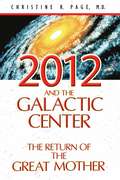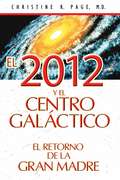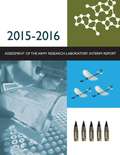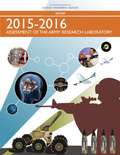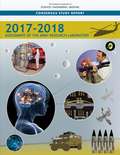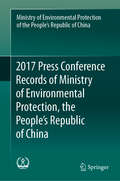- Table View
- List View
18th and 19th Century Porcelain Analysis: A Forensic Provenancing Assessment
by Howell G. EdwardsThis book addresses the contributions made by analytical chemistry to the characterisation of 18th and early 19th Century English and Welsh porcelains commencing with the earliest reports of Sir Arthur Church and of Herbert Eccles and Bernard Rackham using chemical digestion techniques and concluding with the most recent instrumental experiments, which together span more than a hundred years of study. From the earliest experiments which required necessarily the sacrifice of significant portions of each specimen, which may already have been damaged , to the latest experiments which needed only microsampling or the non-destructive interrogation of valuable perfect specimens a comprehensive survey is undertaken of more than twenty manufactories of quality porcelains. The correlation is made between the quantitative elemental oxide determinations of the scanning electron microscopic diffraction and Xray fluorescence data and the qualitative molecular spectroscopic Raman data to demonstrate their complementarity and use in the holistic forensic assessment of the origin of the fired procelains ; this will form the groundwork for the adoption of analytical techniques for the attribution of unknown or questionable procelains to their potential source factories . The book will also examine the perception of what constitutes a porcelain and its definitions and examines the assignment of porcelains to types which currently employs the definitions of hard paste , soft paste , hybrid , magnesian and bone china from the conclusions derived from the analytical data and a consideration of the raw materials employed in their manufacturing processes. During the discussion of this analytical evidence several themes and protocols have been established for its utilisation in the potential identification of porcelains and several case studies undertaken for this purpose are cited. The book will be of interest to analytical scientists , to museum ceramics curators and to ceramics historians.
1924–1927: The Dawning of Quantum Mechanics
by Hans-Hennig von Grünberg Alex GriffithsIn June of 1925, almost a hundred years ago, Werner Heisenberg spent ten days on the island of Heligoland - thanks to his hayfever. This respite afforded him the time to write an article that would mark the beginning of the history of modern quantum theory. Two years later, in October of 1927, the fifth Solvay Conference, arguably the most famous gathering in the history of physics, took place in Brussels, bringing the riveting story of the origins of quantum mechanics to a close. During this crucial and relatively short period between 1925 and 1927, eight physicists from five countries developed a theory that would radically change the physical understanding of our world and would become the basis for almost all advanced technologies: transistors, lasers, light-emitting diodes, medical imaging, the electron microscope and much more. The reader will travel through time from September 1924 to October 1927 and learn by way of monthly entries how quantum mechanics came into being, what the people involved experienced and thought in the context of the time they lived in, and how a unified whole slowly emerged from the interactions of these individuals. The book is aimed at laypeople who are fascinated by quantum mechanics and its history. They will learn that this theory, like Anita Berber, jazz or the invention of television, is a characteristic child of the 1920s.
1924–1927: Der Frühling der Quantenmechanik
by Hans-Hennig von GrünbergSeines Heuschnupfens wegen verbrachte Werner Heisenberg im Juni 1925, vor nun bald hundert Jahren, zehn Tage auf der Insel Helgoland, wo er einen Artikel schrieb, der als der Beginn der Geschichte der modernen Quantentheorie angesehen werden kann. Im Oktober 1927 fand die fünfte Solvay-Konferenz in Brüssel statt, die wohl berühmteste Konferenz in der Geschichte der Physik, und brachte die spannende Entstehungsgeschichte der Quantenmechanik zu ihrem vorläufigen Ende. In diesen Jahren zwischen 1925 und 1927 entwickelten acht Physiker aus fünf Ländern eine Theorie, die das physikalische Verständnis unserer Welt radikal verändert sollte. Mit diesem Buch wandert man vom September 1924 bis zum Oktober 1927 durch die Zeit und erfährt dabei in Form von Monatsberichten, wie die Quantenmechanik entstanden ist, was die handelnden Personen erlebt und gedacht, in welcher Zeit sie gelebt haben und wie aus dem Zusammenspiel Einzelner langsam das gemeinsame Ganze entstanden ist. Das Buch wendet sich an Laien, die sich von der Quantenmechanik faszinieren lassen wollen und dabei verstehen werden, dass diese Theorie wie Anita Berber, der Jazz oder die Erfindung des Fernsehens ein typisches Kind der 1920er Jahre ist.
19th Nordic-Baltic Conference on Biomedical Engineering and Medical Physics: Proceedings of NBC 2023, June 12–14, 2023, Liepaja, Latvia (IFMBE Proceedings #89)
by Yuri Dekhtyar Inga SakniteThis book reports on new trends, challenges and solutions, in the multidisciplinary fields of biomedical engineering and medical physics. Contributions spans from biomechanics, to robotic rehabilitation, radiation oncology, and image and signal processing, among many other topics. They cover advanced devices for diagnosis or patient monitoring, as well as for therapy (non-invasive surgery, rehabilitation and more). Gathering the proceedings of the 19th Nordic-Baltic Conference on Biomedical Engineering and Medical Physics, NBC 2023, held on June 12–14, 2023, in Liepaja, Latvia, this book is expected to inform a wide audience of researchers, engineers and other professionals working in the broad field of biomedical engineering, and to offer a timely snapshot of research and projects that have been carried out within Nordic and Baltic countries, in particular, but not limited to them.
1D Oxide Nanostructures Obtained by Sol-Gel and Hydrothermal Methods (SpringerBriefs in Materials)
by Crina Anastasescu Susana Mihaiu Silviu Preda Maria ZaharescuThis book presents wet chemical sol-gel and hydrothermal methods for 1D oxide nanostructure preparation. These methods represent an attractive route to multifunctional nanomaterials synthesis, as they are versatile, inexpensive and, thus, appropriate for obtaining a wide range of oxide materials with tailored morphology and properties. Three specific oxides (SiO2, TiO2, ZnO) are discussed in detail in order to illustrate the principle of the sol-gel and hydrothermal preparation of 1D oxide nanostructures. Other oxides synthesized via this method are also briefly presented. Throughout the book, the correlation between the tubular structure and the physico-chemical properties of these materials is highlighted. 1D oxide nanostructures exhibit interesting optical and electrical properties, due to their confined morphology. In addition, a well-defined geometry can be associated with chemically active species. For example, the pure SiO2 nanotubes presented a slight photocatalytic activity, while the Pt-doped SiO2 tubular materials act as microreactors in catalytic reactions. In the case of titania and titanate nanotubes, large specific surface area and pore volume, ion-exchange ability, enhanced light absorption, and fast electron-transport capability have attracted significant research interest. The chemical and physical modifications (microwave assisted hydrothermal methods) discussed here improve the formation kinetics of the nanotubes. The ZnO nanorods/tubes were prepared as random particles or as large areas of small, oriented 1D ZnO nanostructures on a variety of substrates. In the latter case a sol-gel layer is deposited on the substrate prior to the hydrothermal preparation. Using appropriate dopants, coatings of ZnO nanorods with controlled electrical behavior can be obtained.
1st IFMBE Latin American Conference on Digital Health: Proceedings of CLASD 2024, October 3-5, 2024, Panama City, Panama (IFMBE Proceedings #119)
by Virginia L. Ballarin Ernesto A. Ibarra-Ramírez Sandra M. Pérez-Buitrago Luis R. Berriere Fabiola Martinez-LiconaThis book reports on the latest research and developments in Biomedical Engineering, with a special emphasis on topics of interest and findings achieved in Latin America. It covers applications of artificial intelligence in medical diagnosis, cutting-edge biosignal processing methods, machine learning models in healthcare, and new technologies for medical rehabilitation and diagnosis. Based on the 1st Latin American Conference on Digital Health (CLASD 2024), held on October 3-5, 2024, in Panama City, Panama, this book provides researchers and professionals with extensive information on new technologies for healthcare and current challenges for their clinical applications.
1st International Conference on Mechanics of Solids 2022: Selected Contributions of MS 2022 (Proceedings in Engineering Mechanics)
by António J. M. Ferreira Lucas F. M. da SilvaThis book provides selected papers presented at the 1st International Conference on Mechanics of Solids, held in Porto, Portugal, November 3-4, 2022.The book focuses on the mechanics of deformable solids, dynamics of particles and rigid bodies. Topics like mechanical behaviour of materials, mechanics of composite materials, plasticity, fracture mechanics, and optimum design methods are covered. This volume provides the latest trends related to mechanics of solids and appeals to researchers and practitioners across the broad spectrum.
1st Karl Schwarzschild Meeting on Gravitational Physics (Springer Proceedings in Physics #170)
by Piero Nicolini Matthias Kaminski Jonas Mureika Marcus BleicherThese proceedings collect the selected contributions of participants of the First Karl Schwarzschild Meeting on Gravitational Physics, held in Frankfurt, Germany to celebrate the 140th anniversary of Schwarzschild's birth. They are grouped into 4 main themes: I. The Life and Work of Karl Schwarzschild; II. Black Holes in Classical General Relativity, Numerical Relativity, Astrophysics, Cosmology, and Alternative Theories of Gravity; III. Black Holes in Quantum Gravity and String Theory; IV. Other Topics in Contemporary Gravitation. Inspired by the foundational principle ``By acknowledging the past, we open a route to the future", the week-long meeting, envisioned as a forum for exchange between scientists from all locations and levels of education, drew participants from 15 countries across 4 continents. In addition to plenary talks from leading researchers, a special focus on young talent was provided, a feature underlined by the Springer Prize for the best student and junior presentations.
2-D PAGE Map Analysis: Methods and Protocols (Methods in Molecular Biology #1384)
by Emilio Marengo Elisa RobottiExploring the 2-D gel mapping field, the chapters in this book are separated into four different categories: Part I talks about 2-D maps reproducibility and maps modeling; Part II describes the image analysis tools that provide spot volume datasets; Part III is about the statistical methods applied to spot volume datasets to identify candidate biomarkers; and Part IV discusses differential analysis from direct image analysis tools. 2-D PAGE Map Analysis: Methods and Protocols provides a unique approach to 2-D gel mapping, in that it helps users avoid drawbacks due to ignorance of the basic theoretical mechanisms underlying the technique, including data handling and proper tools for spot analysis. Written in the highly successful Methods in Molecular Biology series format, chapters include introductions to their respective topics, lists of the necessary materials, step-by-step, readily reproducible laboratory protocols, and tips on troubleshooting and avoiding known pitfalls. Cutting-edge and thorough, 2-D PAGE Map Analysis: Methods and Protocols, is a useful resource for any scientist or researcher, with a mathematical background, who is interested in 2-D gel mapping.
2-D Proteome Analysis Protocols (Methods in Molecular Biology #112)
by Andrew J. LinkA step-by-step tour through the complete process of doing proteomics. With easy-to-follow instructions, complete with many helpful hints and explanations, leading investigators and pioneers in the field show how to make protein extracts, reproducibly run them on 2-D gels, detect them, analyze the data, and precisely identify each protein. The book covers the latest methods of using carrier ampholytes in the 1st dimension, casting and running immobilized pH gradient 2-D gels, MALDI-TOF-based peptide mapping, automated tandem mass spectrometry, and nanoelectrospray ionization technology. For the 2nd dimension, there are methods for running flatbed or vertical gels and for protein detection using autoradiography, and Coomassie, silver, and reversible metal-chelate stains. 2-D Proteome Analysis Protocols is the most complete guide for using proteomics to answer biological questions.
2-mm Wave Band EPR Spectroscopy of Condensed Systems
by V. I. KrinichnyiThis is the first book to summarize the problems of using modern high-resolution 2-mm wave band EPR spectroscopy in an interdisciplinary field for the investigation of various condensed systems. The material is well illustrated and the applications are as diverse as possible. The main subjects included are: unique characteristics of 2-mm EPR spectroscopy and appropriate experimental techniques, dynamics and polarity of radical microenvironment in model and biological systems, and the nature of charge carriers and charge transfer mechanisms in organic polymer semiconductors.
20 Years of Computational Neuroscience (Springer Series in Computational Neuroscience #9)
by James M BowerWhen funding agencies and policy organizations consider the role of modeling and simulation in modern biology, the question is often posed, what has been accomplished ? This book will be organized around a symposium on the 20 year history of the CNS meetings, to be held as part of CNS 2010 in San Antonio Texas in July 2010. The book, like the symposium is intended to summarize progress made in Computational Neuroscience over the last 20 years while also considering current challenges in the field. As described in the table of contents, the chapter's authors have been selected to provide wide coverage of the applications of computational techniques to a broad range of questions and model systems in neuroscience. The proposed book will include several features that establish the history of the field. For each article, its author will select an article originally appearing in a CNS conference proceedings from 15 - 20 years ago. These short (less than 6 page) articles will provide illustrations of the state of the field 20 years ago. The new articles will describe what has been learned about the subject in the following 20 years, and pose specific challenges for the next 20 years. The second historical mechanism will be the reproduction of the first 12 years of posters from the CNS meeting. These posters in and of themselves have become famous in the field (they hang in the halls of the NIH in Bethesda Maryland) and were constructed as allegories for the state and development of computational neuroscience. The posters were designed by the book's editor, who will, for the first time, provide a written description of each poster.
200 More Puzzling Physics Problems: With Hints and Solutions
by Péter Gnädig Gyula Honyek Máté Vigh Ken RileyLike its predecessor, 200 Puzzling Physics Problems, this book is aimed at strengthening students' grasp of the laws of physics by applying them to situations that are practical, and to problems that yield more easily to intuitive insight than to brute-force methods and complex mathematics. The problems are chosen almost exclusively from classical, non-quantum physics, but are no easier for that. They are intriguingly posed in accessible non-technical language, and require readers to select an appropriate analysis framework and decide which branches of physics are involved. The general level of sophistication needed is that of the exceptional school student, the good undergraduate, or the competent graduate student; some physics professors may find some of the more difficult questions challenging. By contrast, the mathematical demands are relatively minimal, and seldom go beyond elementary calculus. This further book of physics problems is not only instructive and challenging, but also enjoyable.
200 Puzzling Physics Problems
by P. Gnädig G. Honyek K. F. RileyThis book will strengthen a student's grasp of the laws of physics by applying them to practical situations, and problems that yield more easily to intuitive insight than brute-force methods and complex mathematics. These intriguing problems, chosen almost exclusively from classical (non-quantum) physics, are posed in accessible non-technical language requiring the student to select the right framework in which to analyse the situation and decide which branches of physics are involved. The level of sophistication needed to tackle most of the two hundred problems is that of the exceptional school student, the good undergraduate, or competent graduate student. The book will be valuable to undergraduates preparing for 'general physics' papers. It is hoped that even some physics professors will find the more difficult questions challenging. By contrast, mathematical demands are minimal, and do not go beyond elementary calculus. This intriguing book of physics problems should prove instructive, challenging and fun.
2000 Assessment of the Office of Naval Research's Marine Corps Science and Technology Program
by Commission on Physical Sciences, Mathematics, and Applications Naval Studies Board National Research Council Division on Engineering and Physical Sciences Committee for the Review of ONR's Marine Corps Science and Technology ProgramThis review of the Science and Technology (S&T) program of the Office of Naval Research's (ONR's) Expeditionary Warfare Operations Technology Division, Code 353, comes at a time of considerable change in the Marine Corps and in ONR, which are currently in the midst of significant transitions. The Marine Corps is making plans to equip and train for engaging in a new style of warfare known as Operational Maneuver From the Sea (OMFTS) and for performing a wide variety of missions in urban settings, ranging from humanitarian assistance to combat and mixes of these suggested by the term three-block war. During 1999, ONR assumed management of that portion of the Marine Corps S&T program that had not been assigned several years earlier to the Marine Corps Warfighting Laboratory (MCWL). In 2002, control of most of ONR's advanced development funding (6.3), and of much of its exploratory development funding (6.2), will move from ONR's line divisions, of which Code 353 is one of many, to 12 new program offices, each dedicated to demonstrating technologies for future naval capabilities (FNCs). Given these changes, it is not surprising that some of the projects inherited recently by ONR, and assessed by the Committee for the Review of ONR's Marine Corps Science and Technology Program under the auspices of the Naval Studies Board of the National Research Council, differed from the customary ONR project and were more akin to preacquisition or acquisition support than to S&T. It is also not surprising that Code 353 could not articulate its plans for future investments clearly and concisely, given the current uncertainty about the content of and funding level for FNCs. The Marine Corps S&T program supports the five imperatives for technology advancement that the Marine Corps Combat Development Command (MCCDC) has identified as prerequisites for the transition to OMFTS: maneuver, firepower, logistics, training and education, and command and control. The committee supports investment in these areas and, in the report's discussions and recommendations, follows the five imperatives.
2003 Assessment of the Office of Naval Research's Marine Corps Science and Technology Program
by Committee for the Review of ONR's Marine Corps Science Technology ProgramThe Office of Naval Research (ONR) funds research across a broad range of scientific and engineering disciplines in support of the Navy and Marine Corps. To ensure that its investments are serving those ends and are of high quality, ONR requires each of its departments to undergo annual review. Since 1999, the Naval Expeditionary Warfare Department of ONR has requested that the NRC conduct these reviews. This report presents the results of the second review of the Marine Corps Science and Technology program. The first review was conducted in 2000. The 2003 assessment examines the overall Marine Corps S&T program, the littoral combat future naval capability, the core thrusts of the program, and basic research activities.
2007 Amendments The National Academies' Guidelines For Human Embryonic Stem Cell Research
by National Research Council Institute of Medicine of the National AcademiesIn 2005, the National Academies released the report Guidelines for Human Embryonic Stem Cell Research, which offered a common set of ethical standards for a field that, due to the absence of comprehensive federal funding, was lacking national standards for research. In order to keep the Guidelines up to date, given the rapid pace of scientific developments in the field of stem cell research, the Human Embryonic Stem Cell Research Advisory Committee was established in 2006 with support from The Ellison Medical Foundation, The Greenwall Foundation, and the Howard Hughes Medical Institute. This letter report is the committee's first set of amendments to the Guidelines and clarifies earlier recommendations and conclusions, including the criteria for determining which stem cell lines it is acceptable to use. Future deliberations of the committee will address items for which additional information gathering and more extensive debate and discussion will be necessary.
2012 and the Galactic Center: The Return of the Great Mother
by Christine R. PageA guide to the expansion of consciousness possible during the Galactic Alignment of 2012• Reveals the new era that will be ushered in as the current perception of time collapses and spiritual perception expands • Explains the psycho-spiritual preparations necessary to transition into this new era• Shows how the alignment of the sun with the Galactic Center will allow humans to experience awareness normally reserved for shamans, pharaohs, and sagesThis is an extraordinary time in the planet’s history. In 2012, for the first time in almost 26,000 years, our sun will be most closely aligned to the Galactic Center. This Galactic Alignment, which began with the Harmonic Convergence in 1987 and will conclude in 2023, presents a thirty-six-year window of opportunity for humanity to participate in the creation of a new era of expanded consciousness. Christine Page explains that, as the source of all creation, our galaxy is the Great Mother and its center, her heart. Auspiciously aligning Earth with the heart of the Great Mother, the Galactic Alignment heralds a rebirth of the divine feminine qualities of the Triple Goddess--intuition, emotional creativity, and renewal. Drawing on alchemy and mythology, Page details how to connect with and use the sacred spiritual tools unlocked during the alignment to merge with the Great Mother, a spiritual transformation that allows us to expand our awareness and experience ourselves as eternal beings.
2012 Treasurer's Report
by National Academy of Sciences TreasurerThe income that supports the activities of the Academy comes from two major sources: program revenue received from sponsors to pay for the myriad studies and other activities undertaken each year by the National Research Council (NRC), and a much smaller sum that we obtain from our own endowment under the endowment spending policies adopted by the Council. Regarding the first of these, the 2012 results are not as strong as the 2011 results. Our total program revenue for 2012 ($298 million) experienced a decline of approximately 8% below 2011 revenue. This decline was anticipated based on the ongoing federal budget constraints and we anticipate for 2013 a continuation of this moderate downward trend.<P><P> To partially compensate for the downward trend in the NRC program level, the federal government announced toward the end of 2012, two settlements concerning the 2010 Deepwater Horizon disaster, one with BP Exploration and Production, Inc. and one with Transocean Deepwater, Inc. As part of these legal settlements, the NAS has been asked to establish a new $500 million, 30-year program on human health and environmental protection in the Gulf of Mexico. The NAS program will be for studies conducted based on scientific merit and integrity with emphasis on freedom of inquiry and independent, nonpartisan advice and recommendations. Among its activities, the program will fund projects in the public interest and not otherwise supported by private industry or government agencies. Building on existing Academy work and remaining mindful of the tragic loss of life and other human and environmental consequences of the Deepwater Horizon disaster, the NAS is starting a careful plan to guide the work of this long term program.<P> With respect to the second source of revenue, it has for many years been the formal policy of the Council to limit annual endowment spending to 5% of the average value of endowment for the twelve quarters ending in June of the previous year. When the endowment declined significantly in 2008, the Council made the prudent decision to hold spending to only 4% and to avoid spending whenever possible from endowments with value below the original gift amount, starting in 2009. This 4% draw produced $14.3 million of funding in 2009. These practices will continue for endowment spending in 2013. The return on the endowment in 2012 was positive at approximately 10.2% and roughly in line with the major stock indices.
El 2012 y el centro galáctico: El retorno de la Gran Madre
by Christine R. PageUna guía a la expansión de la conciencia que será posible durante la alineación galáctica de 2012 • Explica los preparativos psicoespirituales necesarios para hacer la transición a esta nueva era • Muestra cómo la alineación del sol con el centro galáctico permitirá a los humanos experimentar la forma de conciencia normalmente reservada para chamanes, faraones y sabios En 2012, por primera vez en casi 26.000 años, nuestro sol estará casi perfectamente alineado con el centro galáctico. Christine Page explica que, como fuente de toda creación, nuestra Galáctica es la Gran Madre y su centro es su corazón. Al alinearse la Tierra con el corazón de la Gran Madre, la alineación galáctica anuncia el renacimiento de las divinas cualidades femeninas de la Diosa Triple: la intuición, la creatividad emocional y la renovación. Basada en la alquimia y la mitología, Page detalla cómo conectarse y cómo usar los medios espirituales sagrados descubiertos durante la alineación para fundirnos con la Gran Madre, una transformación espiritual que nos permitirá expandir nuestra conciencia y experimentarnos a nosotros mismos como seres eternos.
2013-2014 Assessment of the Army Research Laboratory: Interim Report
by Army Research Laboratory Technical Assessment BoardThe National Research Council's Army Research Laboratory Technical Assessment Board provides biennial assessments of the scientific and technical quality of the research, development, and analysis programs at the Army Research Laboratory, focusing on ballistics sciences, human sciences, information sciences, materials sciences, and mechanical sciences. This interim report summarizes the findings of the Board for the first year of this biennial assessment. During the first year the Board examined the following elements: within ballistic sciences, terminal ballistics; within human sciences, translational neuroscience and soldier simulation and training technology; within information sciences, autonomous systems; and within materials sciences, energy materials and devices, photonic materials and devices, and biomaterials. The review of autonomous systems included examination of the mechanical sciences competency area for autonomous systems. A second, final report will subsume the findings of this interim report and add the findings from the second year of the review, during which the Board will examine additional elements.
2015-2016 Assessment of the Army Research Laboratory: Interim Report
by National Academies of Sciences Engineering MedicineThe National Academies of Sciences, Engineering, and Medicine's Army Research Laboratory Technical Assessment Board (ARLTAB) provides biennial assessments of the scientific and technical quality of the research, development, and analysis programs at the Army Research Laboratory (ARL), focusing on ballistics sciences, human sciences, information sciences, materials sciences, and mechanical sciences. This interim report summarizes the findings of the Board for the first year of this biennial assessment; the current report addresses approximately half the portfolio for each campaign; the remainder will be assessed in 2016. During the first year the Board examined the following elements within the ARL's science and technology campaigns: biological and bioinspired materials, energy and power materials, and engineered photonics materials; battlefield injury mechanisms, directed energy, and armor and adaptive protection; sensing and effecting, and system intelligence and intelligent systems; advanced computing architectures, computing sciences, data-intensive sciences, and predictive simulation sciences; human-machine interaction, intelligence and control, and perception; humans in multiagent systems, real-world behavior, and toward human variability; and mission capability of systems. A second, final report will subsume the findings of this interim report and add the findings from the second year of the review.
2015-2016 Assessment of the Army Research Laboratory
by National Academies of Sciences Engineering MedicineThe National Academies of Sciences, Engineering, and Medicine’s Army Research Laboratory Technical Assessment Board (ARLTAB) provides biennial assessments of the scientific and technical quality of the research, development, and analysis programs at the Army Research Laboratory (ARL), focusing on ballistics sciences, human sciences, information sciences, materials sciences, and mechanical sciences. This biennial report summarizes the findings of the ARLTAB from the reviews conducted by the panels in 2015 and 2016 and subsumes the 2015-2016 interim report.
2017-2018 Assessment of the Army Research Laboratory: Interim Report
by National Academies of Sciences Engineering MedicineThe Army Research Laboratory (ARL) is the corporate laboratory for the U.S. army, which bridges scientific and military communities. The ARL is critical in maintaining the United States’ dominant military power through its advanced research and analysis capabilities. The National Academies of Sciences, Engineering, and Medicine's Army Research Laboratory Technical Assessment Board (ARLTAB) conducts biennial assessments of the scientific and technical quality of the facilities. These assessments are necessary to ensure that the ARL’s resources and quality of programs are maximized. 2017-2018 Assessment of the Army Research Laboratory includes findings and recommendations regarding the quality of the ARL’s research, development, and analysis programs. The report of the assessment is subdivided by the ARL’s Science and Technology campaigns, including Materials Research, Sciences for Lethality and Protection, Information Sciences, Computational Sciences, Sciences for Maneuver, Human Sciences, and Analysis and Assessment. This biennial report summarizes the findings for the 2017-2018 period.
2017 Press Conference Records of Ministry of Environmental Protection, the People's Republic of China
by Min. of Environmental Protection of RPCThis book introduces readers to the press release work carried out by China’s Ministry of Environmental Protection in 2017. The routine press release work in 2017 was first launched by the Ministry of Environmental Protection (MEP). In 2017, 12 directors of the MEP and three directors of the Environmental Protection Department of the Beijing-Tianjin-Hebei Tribune came together to answer citizens’ questions on key social issues such as Environmental Quality Monitoring, Prevention of Air Pollution, Ecosystem Protection, Water Pollution Prevention, Environmental Supervision, Legal Enforcement etc. This book will provide readers with an overview of China’s environmental protection policy initiatives, help raise public awareness of the environment, and lay the foundation for all citizens to participate in environmental governance.
